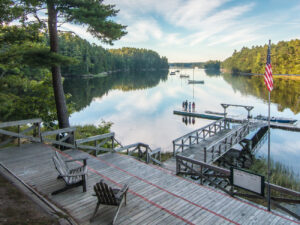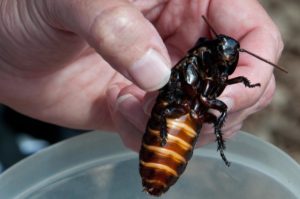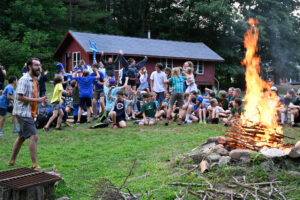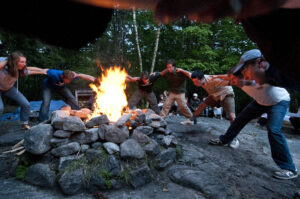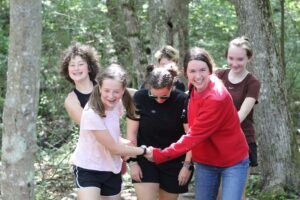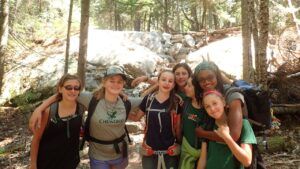Hello from Chewonki Neck. We are excited to present the first issue of our Camp Chewonki@Home Newsletter for the 2021-2022 season. Each month we will bring you updates from the Neck, including Salt Marsh Farm and the Wildlife Center, as well as important information to help you get ready for camp. We will also provide opportunities for you to connect with friends from this past summer.
If you have any questions, please email camp@chewonki.org.
~With best wishes from all your friends at Camp Chewonki!
News from the Neck
It’s been a beautiful and colorful fall season on Maine’s midcoast. Maine gets dark earlier and earlier this time of year and the fields and woods are full of creatures getting ready for winter. Some of those animals are “nocturnal”, which means they are active during the night and sleep during the day. What nocturnal animals live where you do?

The majority of Maine mammals are nocturnal. Inside our Wildlife Center, we have a Virginia Opossum named ‘Ginny’ who is currently our only resident mammal. They have a prehensile tail that aids them in climbing and gathering materials for their home, which is why Ginny lives with us – she is missing her tail, and would have a difficult time surviving without that incredible adaptation. While she has an outdoor enclosure that she enjoyed exploring all summer, she is now indoors as we prepare for colder weather and continue to train with her for upcoming programs.
Our Wildlife Center is also home to other nocturnal wildlife. We have an aviary housing 8 permanent resident owls, all of them species that could be encountered in the Maine woods. All of our owls have social or physical handicaps that impede their ability to survive in the wild and we are honored to count them as fellow teachers and wildlife ambassadors.

Our two Great Horned Owls (Sparky and Archie) are the largest year-round resident owl in Maine. You may hear them after dark hooting their distinctive call of “Whooo’s awake? Meee Too” across the night. This sound is often used in Hollywood horror movies, to establish a ‘spooky’ woods.

We have two Barred Owls (Varia and Luna). These owls are one of the few species of dark-eyed owls in Maine. They are sometimes called Swamp Owls or Ghost Owls for their light colors, dark eyes, and spooky ‘Owl’oween spirit. They are a very vocal owl, making the well known “Whoo cooks for you, Whoo Cooks for you all?” call. Barred Owls are a common resident of wet woodlands – so if you have woods near you with a pond or river running through it, you probably have some feathered neighbors hunting the local rodents and amphibians.

We have two Eastern Screech Owls (Woden and Ozzy), who don’t really screech but make a sound like a mournful horse whinny. They are less common here in Maine, but still possible to come across. They are often mistaken for a ‘baby Great Horned Owl’, because they look very similar to the larger species, but despite their size they are full-grown predators, hunting mice and also many meaty bugs in the summertime.

We have two Northern Saw-Whet Owls (Caribou and Haven), the smallest species of owl in Maine, and the 2nd smallest in North America, bested only by the tiny lil’ Elf Owl down south (but this is Halloween, so we’ll leave the elves out of this :P). Saw-Whet owls are named for the sound they make, which many believe sounds like a saw blade being sharpened on a whetstone, a “Pip! Pip! Pip!” sound that carries through the night.

And finally, well suited to a Halloween stroll through creatures that go bump in the night, is our cuddly-looking Rose-Haired Tarantula, named Tula. Tula is a Chilean Rose-Hair, from Chile, and she has a rosy coloration due to her many hair-like bristles that make her look fuzzy – but in reality, they are a prickly protective adaptation, causing irritation to the skin.
While there are no species of tarantulas living in Maine, she is a large and charismatic representative of the 40 unique species of spiders that can be found in the state. Half of those spiders are your classic web-building spiders, such as orb-weavers, or funnel-web spiders. But tarantulas are wandering spiders, similar to wolf spiders, that can be found here in Maine. Instead of building a web to wait for their food, they are a bit more hands-on, hunting and pouncing on their prey (no worries, people aren’t prey – they feed on insects like crickets and beetles).
Written by Kyle Wonser, Chewonki Science Educator
Notes From The Camp Office
2022 Enrollment
Some camp programs are already full. Please reach out to the Camp Office if you have any questions. If you have not enrolled for 2022 yet we recommend doing so as soon as possible.
Chewonki Store
Looking for holiday gift ideas? We have some fun new items in our store for the campers in your life (young and old). We’re offering a 15% discount on all orders for camp families! Use discount code SEEYOUIN22 at checkout.
Packing Lists
We are currently updating our packing lists for the 2022 season. Please feel free to review last year’s lists in the meantime.
Camper Directory
We have received many requests from camp families asking for contact information to keep the campers in touch in the off-season. Camper contact information will only be shared with their specific cabin mates.
Please complete this very brief form and let us know if you’d like to opt-in or out. If you choose to opt-in you will be asked for the mailing address and/or email address that you’d like your child to use.
Feel free to reach out to Leslie Hunter if you have any questions or concerns.
